Lady Luck Smiles on Ogunquit ‘Guys and Dolls’
Delicious re-creation of Tony Award-winning 1992 Broadway revival stars Richard Kind, Liz Larsen, Glory Crampton and Christian Hoff at the famed Maine summer playhouse
If it ain’t broke, don’t fix it. These are words the Ogunquit Playhouse has obviously chosen to live by in staging its delightfully earnest re-creation of the 1992 Tony Award-winning revival of the classic American musical Guys and Dolls. 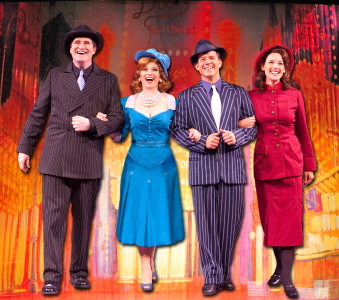 Unlike the much-maligned – and short-lived – Broadway version that Des McAnuff helmed this past spring, the Ogunquit production wisely relies on good old-fashioned faith in the material to elicit refreshingly original performances that crackle and shine.
Unlike the much-maligned – and short-lived – Broadway version that Des McAnuff helmed this past spring, the Ogunquit production wisely relies on good old-fashioned faith in the material to elicit refreshingly original performances that crackle and shine.
Directed by Steven Beckler, the 1992 production supervisor under Tony Award winner Jerry Zaks, this Guys and Dolls bursts with color and light, energetically bringing to life Damon Runyon’s fabled Times Square denizens – gamblers, chorus girls, mobsters and evangelists – all exquisitely coiffed and costumed in circa 1950 fantasy comic book style. Brawny guys’ guys spew Swerling and Burrows’ faux-elegant low-brow vernacular with a natural ease and, along with their various dolls and the sincere missionaries who are doggedly out to save their souls, strike a perfect balance between exaggerated cartoon caricature stereotypes and the living, breathing imperfect people whose hearts all yearn for something bigger underneath.
In the lead roles, a quartet of bona fide Broadway theater professionals merrily work their way through the show’s animated book and beautifully interwoven jazz-inflected score. 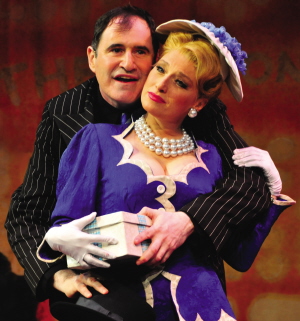 Richard Kind of TV’s Spin City and Mad About You is a thoroughly endearing Nathan Detroit, the hangdog “entrepreneur” who tries desperately to keep his long-suffering fiancée of 14 years Miss Adelaide (the fabulous Liz Larsen) at bay while coming up with the bankroll and the hideaway to operate his “oldest established permanent floating crap game in New York.” His $1000 bet with the suave tough-guy Sky Masterson (a rather bland Christian Hoff who won a Tony Award for his work as bad boy Tommy DeVito in Jersey Boys) sets in motion Sky’s rakish attempt to charm the buttoned up missionary Sarah Brown (a lovely and spunky Glory Crampton) into traveling to Havana with him for dinner. A few broken promises and a number of dulce de leches later, and love proves to be a stronger addiction than either vice or virtue – for either couple.
Richard Kind of TV’s Spin City and Mad About You is a thoroughly endearing Nathan Detroit, the hangdog “entrepreneur” who tries desperately to keep his long-suffering fiancée of 14 years Miss Adelaide (the fabulous Liz Larsen) at bay while coming up with the bankroll and the hideaway to operate his “oldest established permanent floating crap game in New York.” His $1000 bet with the suave tough-guy Sky Masterson (a rather bland Christian Hoff who won a Tony Award for his work as bad boy Tommy DeVito in Jersey Boys) sets in motion Sky’s rakish attempt to charm the buttoned up missionary Sarah Brown (a lovely and spunky Glory Crampton) into traveling to Havana with him for dinner. A few broken promises and a number of dulce de leches later, and love proves to be a stronger addiction than either vice or virtue – for either couple.
Frank Loesser’s intoxicating character-driven score filled with unforgettable words and music sounds fresh and new here, delivered with truth, vim and vigor by a vocally gifted cast that, for the most part, is perfectly suited to their roles. Music director Ken Clifton’s swinging seven-piece orchestra also effortlessly shifts from the smooth romantic tones of Loesser’s love ballads to the pulsating masculine rhythms that spring from the underbelly of a bygone Broadway and 42nd Street. The richly harmonic gambler’s hymn “The Oldest Established” and the rollicking revivalist gospel “Sit Down, You’re Rockin’ the Boat” articulate the sublime paradox of gambling as religion magnificently.
To read my complete review at BroadwayWorld.com, click here.
PHOTOS: Richard Kind as Nathan Detroit, Liz Larsen as Miss Adelaide, Christian Hoff as Sky Masterson and Glory Crampton as Sarah Brown; Richard Kind and Liz Larsen
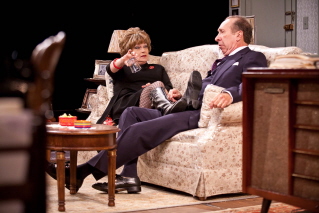 Often sets and costumes replicate the overdone psychedelic sensibilities of Laugh-In while actors bury real feelings beneath contrived posturing.
Often sets and costumes replicate the overdone psychedelic sensibilities of Laugh-In while actors bury real feelings beneath contrived posturing.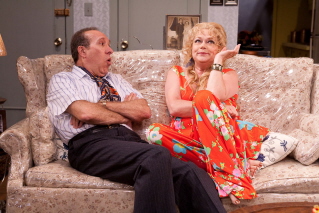 morphs effortlessly from one imperfect lover to another. Her Elaine is brash, crude, and unapologetic, a sexually aggressive married woman whose callous promiscuity can’t quite hide some unnamed deeper wound. As Bobbi, MacDonald is a slightly airheaded new age chatterbox who slowly and deliciously descends from endearingly goofy to frighteningly paranoid, telling more and more bizarre stories about “psycho” boyfriends from her past. Then as the disguise-wearing, purse-clutching, morosely neurotic housewife Jeanette, she drives Baltin’s Barney to distraction until they finally both realize what they have been looking for all along.
morphs effortlessly from one imperfect lover to another. Her Elaine is brash, crude, and unapologetic, a sexually aggressive married woman whose callous promiscuity can’t quite hide some unnamed deeper wound. As Bobbi, MacDonald is a slightly airheaded new age chatterbox who slowly and deliciously descends from endearingly goofy to frighteningly paranoid, telling more and more bizarre stories about “psycho” boyfriends from her past. Then as the disguise-wearing, purse-clutching, morosely neurotic housewife Jeanette, she drives Baltin’s Barney to distraction until they finally both realize what they have been looking for all along.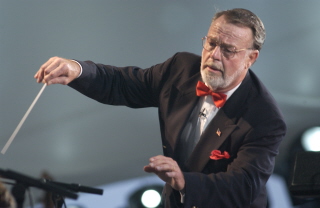 The final concert of the Boston Pops’ 124th season presented on Sunday, June 21, was a bit out of step with the stellar evenings that have preceded it this spring, despite its promise to get the joint jumpin’ with a program of Big Band music called Let’s Dance. Led by guest conductor Erich Kunzel, maestro of the Cincinnati Pops, the orchestra sounded a bit lackluster performing arrangements geared more toward the dance floor than the concert hall.
The final concert of the Boston Pops’ 124th season presented on Sunday, June 21, was a bit out of step with the stellar evenings that have preceded it this spring, despite its promise to get the joint jumpin’ with a program of Big Band music called Let’s Dance. Led by guest conductor Erich Kunzel, maestro of the Cincinnati Pops, the orchestra sounded a bit lackluster performing arrangements geared more toward the dance floor than the concert hall. As the evening went along, most of the dance tunes began to sound somewhat alike. “Take the A Train,” “Caravan,” and “Zing Went the Strings of My Heart” were jazzy fun, and “String of Pearls” was a creamy romantic mood piece. But “Let Yourself Go,” an Al Hirt-less “Java,” and “One O’Clock Jump” came across as merely loud and undifferentiated. A jiving “Sing Sing Sing” would have helped liven things up considerably. The orchestra did build to a nice finish with three very different interpretations, however: a bouncy “Get Happy” that injected an airy string mix into the horns, an unusual instrumental round of “Brother John” (Frere Jacques), and the vibrant Dixieland celebration, “Darktown Strutters Ball.” Here clarinet and trombone were featured to great effect.
As the evening went along, most of the dance tunes began to sound somewhat alike. “Take the A Train,” “Caravan,” and “Zing Went the Strings of My Heart” were jazzy fun, and “String of Pearls” was a creamy romantic mood piece. But “Let Yourself Go,” an Al Hirt-less “Java,” and “One O’Clock Jump” came across as merely loud and undifferentiated. A jiving “Sing Sing Sing” would have helped liven things up considerably. The orchestra did build to a nice finish with three very different interpretations, however: a bouncy “Get Happy” that injected an airy string mix into the horns, an unusual instrumental round of “Brother John” (Frere Jacques), and the vibrant Dixieland celebration, “Darktown Strutters Ball.” Here clarinet and trombone were featured to great effect.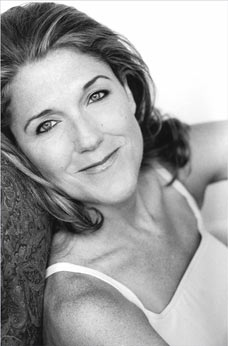 The evening played to Clark’s considerable strengths as an actress, setting her free from the traditional concert format and letting her move about the stage in character. Singing effortlessly and seeming completely at ease, Clark delivered penetrating renditions of her more somber numbers and frolicked through several lighter selections that showed off delightful comic skills.
The evening played to Clark’s considerable strengths as an actress, setting her free from the traditional concert format and letting her move about the stage in character. Singing effortlessly and seeming completely at ease, Clark delivered penetrating renditions of her more somber numbers and frolicked through several lighter selections that showed off delightful comic skills. There are times during Kathy St. George’s performance of Dear Miss Garland – her musical “love letter” to the woman she says has fascinated her ever since she first saw the movie The Wizard of Oz – when her resemblance to the legendary singer and actress is uncanny. She has the same petite, four-foot-eleven frame as Judy had. She wears her dark hair close-cropped and tousled. She gestures her hands nervously and positions her arms akimbo on jutted hips in stunning visual recreations. And every so often she utters a pixie-ish little giggle that eerily reincarnates the late great star of the silver screen.
There are times during Kathy St. George’s performance of Dear Miss Garland – her musical “love letter” to the woman she says has fascinated her ever since she first saw the movie The Wizard of Oz – when her resemblance to the legendary singer and actress is uncanny. She has the same petite, four-foot-eleven frame as Judy had. She wears her dark hair close-cropped and tousled. She gestures her hands nervously and positions her arms akimbo on jutted hips in stunning visual recreations. And every so often she utters a pixie-ish little giggle that eerily reincarnates the late great star of the silver screen.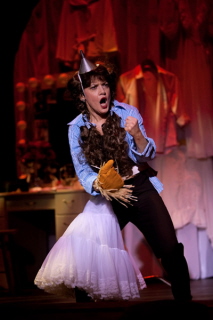 The highlight of Act I, however, is without a doubt St. George’s manic abridgement of The Wizard of Oz. In five minutes (more or less) she enacts the entire movie, playing all the characters – Toto, too! – using hilarious low-budget props to suggest a tornado, Glinda’s bubble, Auntie Em inside a crystal ball, and the Wizard’s fast-disappearing hot-air balloon. “No wonder Judy was on speed,” she quips as she brings the torrent of sight gags to a rapid end.
The highlight of Act I, however, is without a doubt St. George’s manic abridgement of The Wizard of Oz. In five minutes (more or less) she enacts the entire movie, playing all the characters – Toto, too! – using hilarious low-budget props to suggest a tornado, Glinda’s bubble, Auntie Em inside a crystal ball, and the Wizard’s fast-disappearing hot-air balloon. “No wonder Judy was on speed,” she quips as she brings the torrent of sight gags to a rapid end.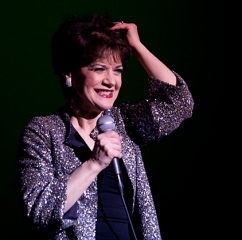 Again St. George has Garland’s physical mannerisms down pat. But now even more than in the first act the disparity between her look and sound is jarring. We want so much to be treated to the original’s rich, effortless vocals that alternately resonate and soar on numbers like “Chicago,” “The Man That Got Away,” “Get Happy,” and “Over the Rainbow.” Instead we see the unmistakable energy and pizzazz of an unforgettable legend but hear the voice of a performer better suited to less iconic songs.
Again St. George has Garland’s physical mannerisms down pat. But now even more than in the first act the disparity between her look and sound is jarring. We want so much to be treated to the original’s rich, effortless vocals that alternately resonate and soar on numbers like “Chicago,” “The Man That Got Away,” “Get Happy,” and “Over the Rainbow.” Instead we see the unmistakable energy and pizzazz of an unforgettable legend but hear the voice of a performer better suited to less iconic songs. I didn’t think The Color Purple would make me cry again after having seen the electrifying performance on Broadway of Fantasia Barrino, Tony Award winner LaChanze’s worthy replacement, shortly before the show ended its successful 910-performance run. But I was wrong. At the Bushnell in Hartford the other night the stellar cast of this powerful national tour – headed by the wonderful Kenita R. Miller in the title role – gently poured its spirit of hope and sisterhood over me until, in the show’s final jubilant moments, I could do nothing but succumb.
I didn’t think The Color Purple would make me cry again after having seen the electrifying performance on Broadway of Fantasia Barrino, Tony Award winner LaChanze’s worthy replacement, shortly before the show ended its successful 910-performance run. But I was wrong. At the Bushnell in Hartford the other night the stellar cast of this powerful national tour – headed by the wonderful Kenita R. Miller in the title role – gently poured its spirit of hope and sisterhood over me until, in the show’s final jubilant moments, I could do nothing but succumb.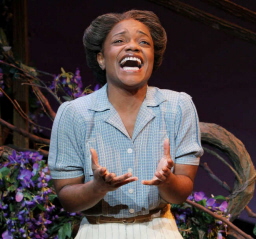 Spanning 40 years in rural Georgia from 1909 to 1949, The Color Purple chronicles the sexual, emotional, and spiritual awakening of the introverted and abused Celie, whose only foothold against darkness and despair is her ability to express her thoughts and feelings through letters to God. Separated from her sister and two children when no more than a child herself and given away by her widowed father to serve as the overbearing Mister’s housekeeper, wife and field hand, Celie gradually emerges as a self-reliant and joyful woman thanks to the inspiration of the defiant Sofia and the love of her husband’s beautiful and exciting mistress Shug Avery. Shug teaches Celie to see her own good and rejoice in life’s beauty, even when prayers seem to fall on deaf ears.
Spanning 40 years in rural Georgia from 1909 to 1949, The Color Purple chronicles the sexual, emotional, and spiritual awakening of the introverted and abused Celie, whose only foothold against darkness and despair is her ability to express her thoughts and feelings through letters to God. Separated from her sister and two children when no more than a child herself and given away by her widowed father to serve as the overbearing Mister’s housekeeper, wife and field hand, Celie gradually emerges as a self-reliant and joyful woman thanks to the inspiration of the defiant Sofia and the love of her husband’s beautiful and exciting mistress Shug Avery. Shug teaches Celie to see her own good and rejoice in life’s beauty, even when prayers seem to fall on deaf ears.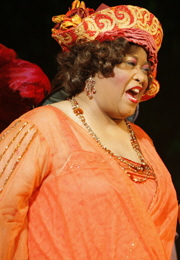 As the pained yet ever hopeful Celie, Kenita R. Miller is quite simply stunning. Her face is a canvas on which her emotions appear with breathtaking sincerity, and her voice infuses every song with a resonance that is deeply moving. “I’m Here,” her self-affirming anthem in which she finally embraces her own virtues and celebrates her unwavering inner strength and dignity, is a triumph of determination over adversity.
As the pained yet ever hopeful Celie, Kenita R. Miller is quite simply stunning. Her face is a canvas on which her emotions appear with breathtaking sincerity, and her voice infuses every song with a resonance that is deeply moving. “I’m Here,” her self-affirming anthem in which she finally embraces her own virtues and celebrates her unwavering inner strength and dignity, is a triumph of determination over adversity.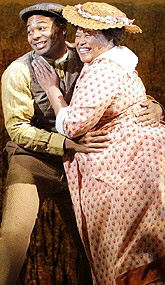 Brandon Victor Dixon as Sofia’s on-again-off-again husband Harpo is an adorable boy/man whose sparkling love-hate relationship with Sofia brings many lighter moments to the show. Their playful duet “Any Little Thing” which marks their long-overdue reconciliation is both humorous and steamy. Rufus Bonds, Jr. as Celie’s abusive husband Mister garners all the enmity he deserves, but he also manages to earn a modicum of sympathy when his own tortured past comes to life in a gut-wrenching soliloquy called “Celie’s Curse.” As Nettie, Celie’s gentle older sister whose promise of survival is the only spiritual lifeline Celie has, Latrisa A. Harper (the understudy for LaToya London) gives an understated performance glowing with compassion and love. Soft voiced and delicately featured, she conveys a placid optimism that ignites Miller’s joy whenever they make a connection, real or imagined.
Brandon Victor Dixon as Sofia’s on-again-off-again husband Harpo is an adorable boy/man whose sparkling love-hate relationship with Sofia brings many lighter moments to the show. Their playful duet “Any Little Thing” which marks their long-overdue reconciliation is both humorous and steamy. Rufus Bonds, Jr. as Celie’s abusive husband Mister garners all the enmity he deserves, but he also manages to earn a modicum of sympathy when his own tortured past comes to life in a gut-wrenching soliloquy called “Celie’s Curse.” As Nettie, Celie’s gentle older sister whose promise of survival is the only spiritual lifeline Celie has, Latrisa A. Harper (the understudy for LaToya London) gives an understated performance glowing with compassion and love. Soft voiced and delicately featured, she conveys a placid optimism that ignites Miller’s joy whenever they make a connection, real or imagined.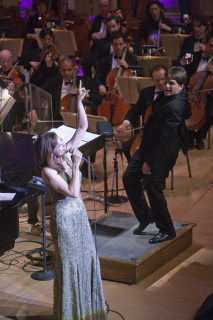 purity and facility that are reminiscent of Garland but never self-consciously so. Her moody “By Myself” is particularly effective, ranging from a soft, slow sadness in the beginning to a loud and proud, joyously liberated finish in which she positively beams. Her “Somewhere Over the Rainbow,” sung as a down-tempo lullaby with just a hint of piano accompaniment, is quite simply magnificent. So powerful is her gentle plea that the audience sits transfixed, quiet enough to hear a pin drop.
purity and facility that are reminiscent of Garland but never self-consciously so. Her moody “By Myself” is particularly effective, ranging from a soft, slow sadness in the beginning to a loud and proud, joyously liberated finish in which she positively beams. Her “Somewhere Over the Rainbow,” sung as a down-tempo lullaby with just a hint of piano accompaniment, is quite simply magnificent. So powerful is her gentle plea that the audience sits transfixed, quiet enough to hear a pin drop.